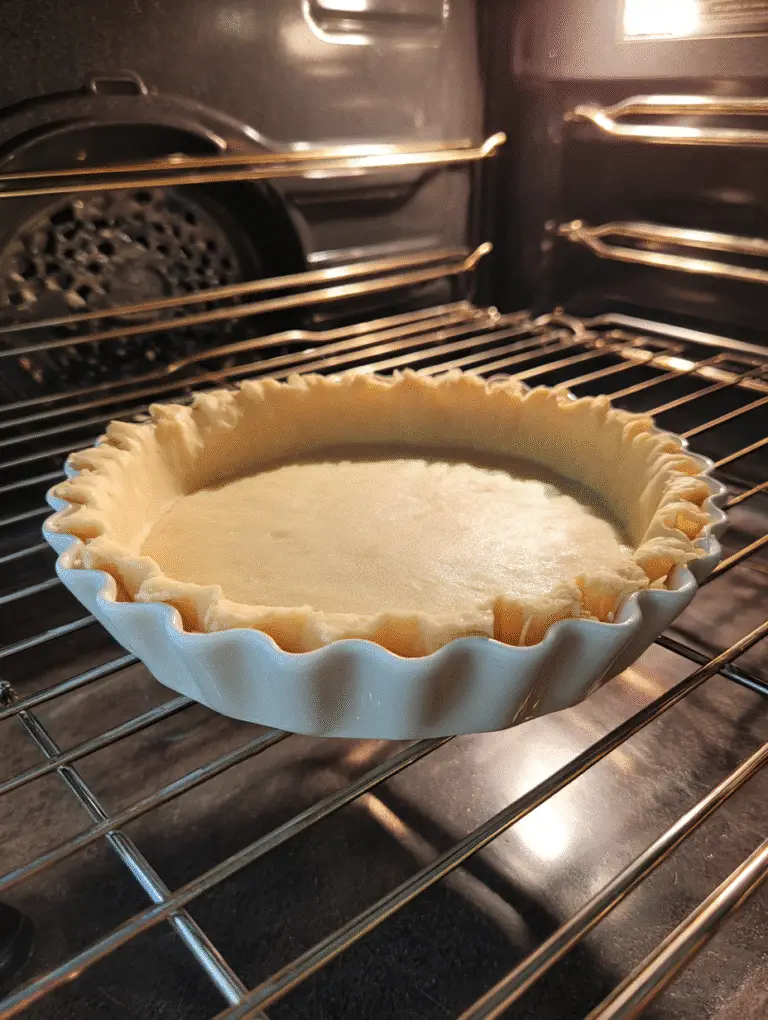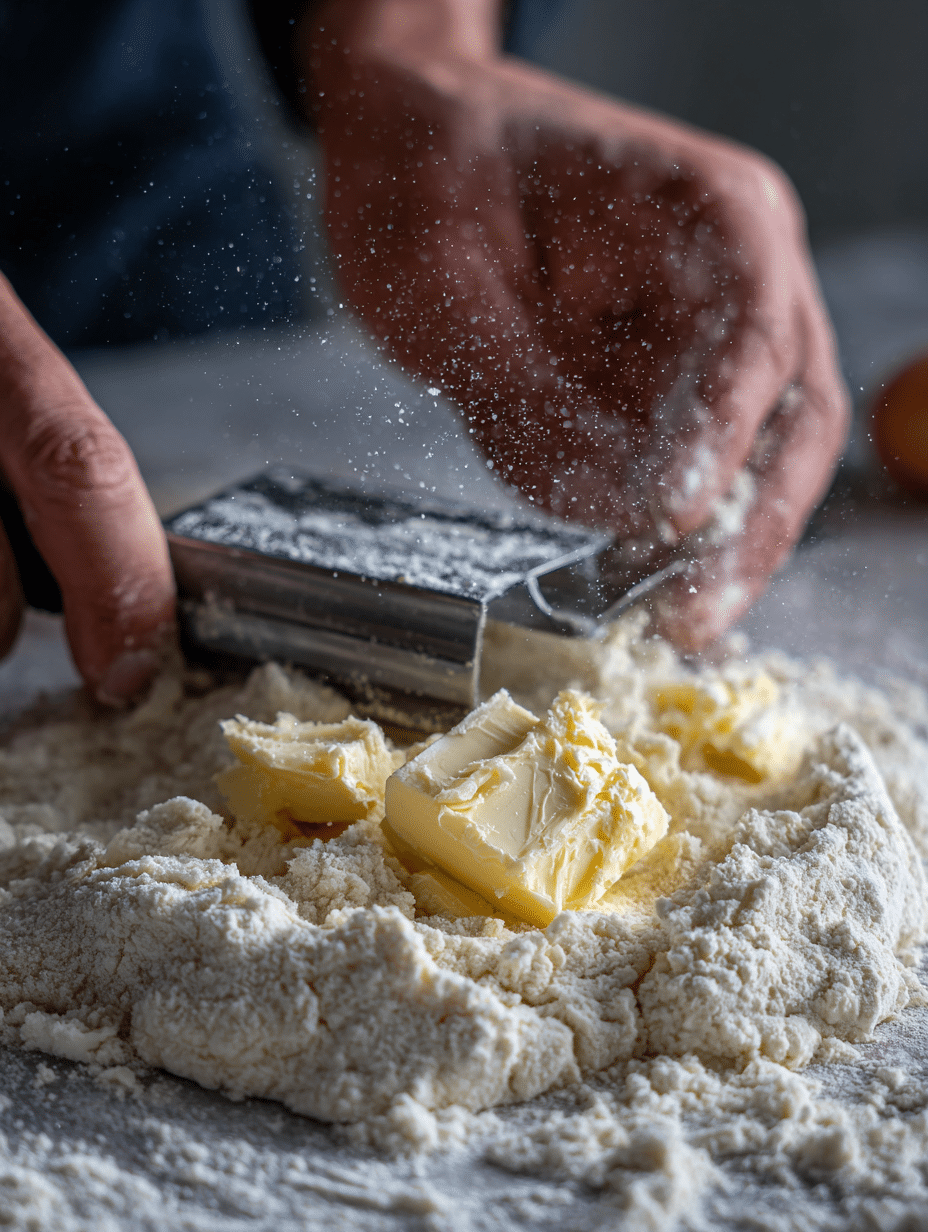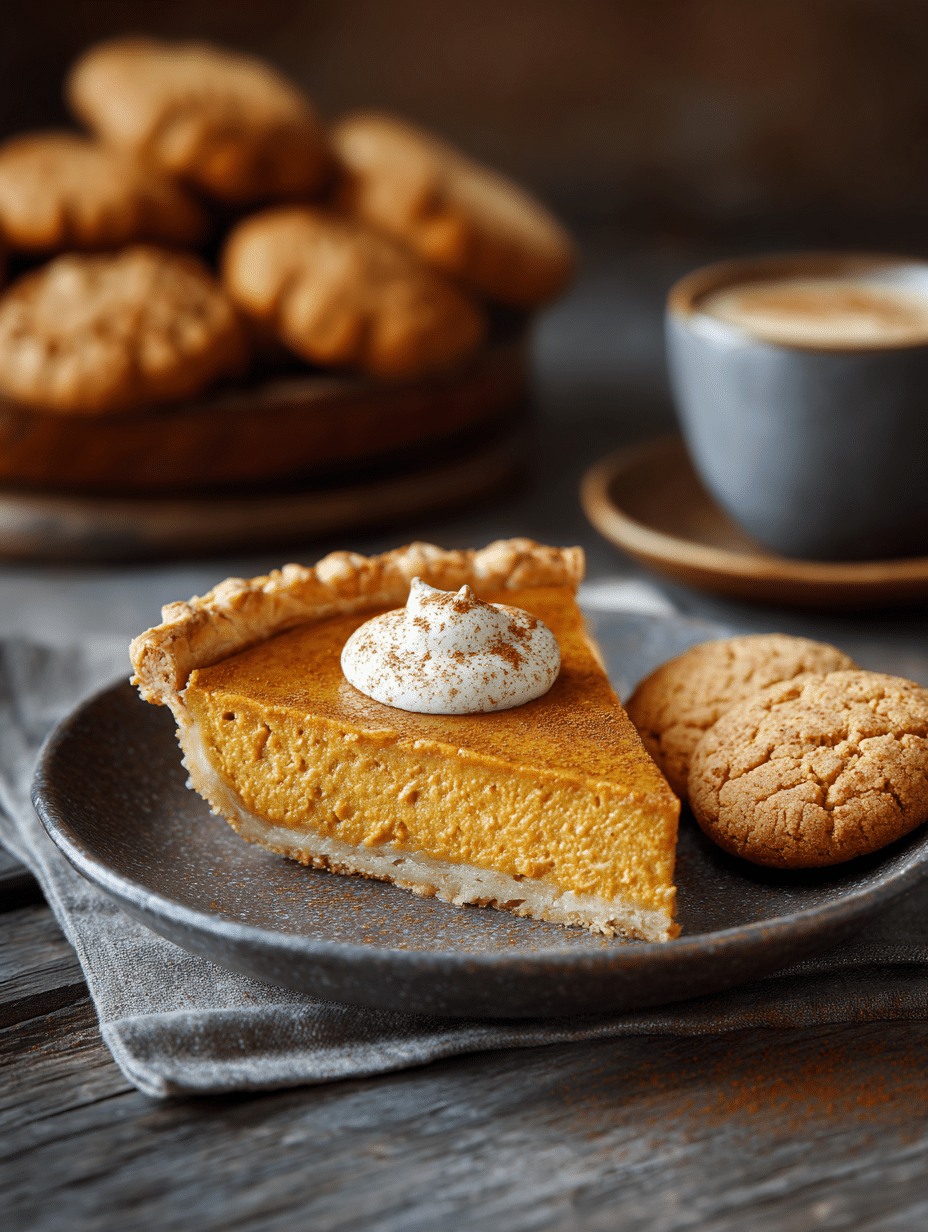If you’ve ever struggled with a soggy or tough crust, this pie crust recipe will be your go-to from now on. It’s buttery, tender, and shatteringly crisp at the edges—everything a pie crust should be. Whether you’re baking a fruit-filled dessert, savory quiche, or creamy pie, a homemade crust sets the foundation for a memorable dish.
In this article, you’ll learn how to make a pie crust recipe that works every time. We’ll cover essential ingredients, rolling techniques, baking tips, and troubleshooting tricks so you can master it with ease.
Looking for a delicious dessert to fill it with? Don’t miss our Pumpkin Cheesecake Squares—they’re even better with homemade crust.
Table of Contents

Pie Crust Recipe – Flaky, Buttery, Foolproof Every Time
This classic pie crust recipe yields a buttery, flaky, and reliable crust every time. Perfect for sweet or savory pies, it’s simple to make and easy to roll out—ideal for beginners and pros alike.
- Total Time: 35 minutes (plus chilling)
- Yield: 2 pie crusts 1x
Ingredients
- 2 1/2 cups all-purpose flour
- 1 tsp salt
- 1 tbsp granulated sugar (optional, for sweet pies)
- 1 cup (2 sticks) unsalted butter, very cold and cubed
- 6–8 tbsp ice water
Instructions
- In a large mixing bowl, whisk together the flour, salt, and sugar (if using).
- Add the cold, cubed butter. Use a pastry cutter or your fingers to cut the butter into the flour until the mixture resembles coarse crumbs with some pea-sized bits.
- Drizzle in ice water 1 tablespoon at a time, mixing with a fork until the dough just comes together. Stop once it holds together without being sticky.
- Divide the dough in half and shape into two discs. Wrap each disc tightly in plastic wrap and refrigerate for at least 1 hour (or up to 2 days).
- When ready to use, roll out the dough on a lightly floured surface to about 1/8-inch thickness. Proceed with your pie recipe as directed.
- For blind baking, preheat oven to 375°F (190°C). Line the crust with parchment and fill with pie weights. Bake for 15–17 minutes, then remove weights and bake 5–7 minutes more until golden.
Notes
For extra flakiness, use a mix of butter and shortening. The dough can be frozen for up to 3 months—thaw overnight in the fridge before using. This recipe makes enough for two 9-inch pie crusts.
- Prep Time: 15 minutes
- Cook Time: 20 minutes (if blind baking)
- Category: Basics
- Method: Baking
- Cuisine: American
- Diet: Vegetarian
Nutrition
- Serving Size: 1 crust (1/8 of recipe)
- Calories: 210
- Sugar: 1g
- Sodium: 150mg
- Fat: 14g
- Saturated Fat: 9g
- Unsaturated Fat: 4g
- Trans Fat: 0g
- Carbohydrates: 18g
- Fiber: 1g
- Protein: 2g
- Cholesterol: 30mg
Why Homemade Pie Crust Beats Store-Bought
Texture, Flavor, and Control
There’s no comparison between a homemade pie crust recipe and a frozen store-bought shell. With your own crust:
- You get rich flavor from real butter
- You control salt, sugar, and thickness
- You create flaky layers that melt in your mouth
Most store crusts are made with cheap oils or preservatives that make them bland or rubbery.
Avoiding Preservatives and Additives
Homemade also means no unnecessary extras:
- No hydrogenated oils
- No artificial colors
- No dough conditioners
Just simple ingredients that come together in minutes. You can even make this pie crust recipe ahead and freeze it until you need it.
Planning to bake a creamy pie? Try it with our No Bake Pumpkin Cheesecake for an elevated twist.
Ingredients You’ll Need for the Perfect Pie Crust
Butter vs. Shortening Debate
The heart of every great pie crust recipe lies in the fat. You have two main options:
- Butter: Gives rich flavor and crisp, flaky texture
- Shortening: Adds tenderness and holds shape better
For the best of both worlds, many bakers use a 50/50 butter-shortening blend. But if you want an all-butter crust with amazing taste, this recipe delivers.
Flour Types, Salt, and Secret Add-Ins
Stick with all-purpose flour for structure. You’ll also need:
- Cold unsalted butter – for distinct flaky layers
- Salt – enhances flavor
- Ice water – helps the dough come together without overworking it
Optional boosts:
- A teaspoon of sugar (great for sweet pies)
- Apple cider vinegar – tenderizes and prevents overdevelopment of gluten
This simple, reliable pie crust recipe creates the perfect foundation whether you’re making savory or sweet dishes. Try it as a base for Pumpkin Pie Bars—you’ll taste the difference immediately.
Step-by-Step – How to Make Flaky Pie Dough

Mixing Dough Without Overworking It
The secret to a perfect pie crust recipe is minimal handling. Here’s how to do it:
- Cut the butter into small cubes and chill it well
- In a large bowl, whisk together 1¼ cups all-purpose flour and ½ teaspoon salt
- Use a pastry cutter or fork to cut butter into the flour until it looks like coarse crumbs with pea-sized pieces
Next, drizzle in 3–4 tablespoons of ice water, one spoonful at a time. Stir gently with a fork. The dough should just come together—don’t knead it like bread.
Press the dough into a disk, wrap it in plastic, and chill for at least 1 hour before rolling.
Rolling, Folding, and Resting the Right Way
After chilling:
- Lightly flour your surface and roll from the center out
- Keep the dough about ⅛ inch thick
- Rotate often to prevent sticking
Want an even flakier crust? Try a quick laminating trick: fold the dough in thirds like a letter, roll it out again, then chill once more. It adds layers without extra effort.
This method creates a professional-quality pie crust recipe without stress. If you want more delicious fall treats to serve with your pie, try Pumpkin Chocolate Chip Cupcakes.
Blind Baking and Par-Baking Tips

When and Why to Pre-Bake
Blind baking means baking your pie crust recipe without filling. It’s essential for:
- Cream pies (like chocolate or banana)
- No-bake fillings (like No Bake Pumpkin Cheesecake)
- Preventing soggy bottoms in custard pies
Par-baking is partially baking the crust, then finishing it with the filling inside—perfect for quiches or pumpkin pie bars.
How to Weigh It Down Correctly
To blind bake:
- Roll and fit your dough into the pan
- Chill it for 15–30 minutes
- Line with parchment paper and fill with pie weights (or dried beans/rice)
- Bake at 375°F for 15–17 minutes, remove weights, and bake again for 5–8 minutes until golden
This keeps your pie crust recipe crisp and flat—no puffing or shrinking.
Pro Tip: Dock the crust (poke holes with a fork) if baking without weights. This helps release steam and avoids bubbling.
Looking for a crust that doesn’t need blind baking? Try our Pumpkin Spice Cookies—they’re quick, spiced, and oven-ready in minutes.
Troubleshooting Common Pie Crust Mistakes
Shrinking, Soggy Bottoms, and Cracks
Even the best pie crust recipe can go sideways if a few key steps are skipped. Here’s how to troubleshoot:
1. Shrinking Crust
- Happens when the dough isn’t rested long enough
- Fix: Chill the dough after rolling and again after placing in the pan
2. Soggy Bottoms
- Usually caused by wet fillings or underbaking
- Fix: Par-bake and use an egg wash before adding filling
3. Cracks in Dough
- Often due to dry dough or overmixing
- Fix: Add a bit more ice water next time and handle the dough gently
Fixes and Preventative Tricks
- Roll the dough slightly larger than your pie pan so it doesn’t pull back
- Always chill before baking to keep the crust from melting too fast
- If cracks appear during rolling, press gently with your fingers or patch with extra dough
This pie crust recipe is forgiving—but following these tips helps you avoid frustration and bake like a pro.
Planning a crust-free dessert instead? Try our Cranberry Pumpkin Cake with Cream Cheese Frosting for an easy win.
Best Pies to Make with This Recipe
Fruit Pies, Cream Pies, and Savory Options
Once you’ve nailed this pie crust recipe, the possibilities are endless. It’s a versatile base that works beautifully with:
- Apple, cherry, or blueberry pies – juices bubble up and caramelize perfectly
- Cream pies – such as chocolate, coconut, or banana, when blind baked
- Quiches and savory galettes – use less sugar in the dough for a savory twist
Want a fall classic? This crust pairs wonderfully with pumpkin pies, pecan pies, and custards.
Great for Pumpkin Pie Bars
One of our favorite ways to use this pie crust recipe is in Pumpkin Pie Bars. Simply roll and press the dough into a baking dish, par-bake, and pour your filling on top. It holds its shape, bakes evenly, and slices clean every time.
You can even divide the dough into mini tart shells for individual servings or holiday samplers.
Looking for cupcake-sized bakes instead? Try Pumpkin Chocolate Chip Cupcakes for a grab-and-go option.
Storing, Freezing, and Make-Ahead Tips
Fridge vs. Freezer
One of the best parts about this pie crust recipe is how well it stores. Whether you’re prepping for a holiday feast or batch baking for the season, here’s how to keep it fresh:
Refrigerator Storage:
- Wrap dough discs tightly in plastic wrap
- Store for up to 3 days in the fridge
- Let it sit at room temp for 10–15 minutes before rolling
Freezer Storage:
- Wrap in plastic and place in a freezer bag
- Freeze for up to 3 months
- Thaw overnight in the fridge, not on the counter (to avoid condensation)
You can also freeze a fully rolled-out crust in a pie pan. Just wrap tightly and freeze flat. Bake straight from frozen with a few extra minutes added to the time.
Need a pie recipe that skips the crust altogether? Don’t miss our No Bake Pumpkin Cheesecake—it’s smooth, creamy, and effortless.
Dessert Pairings That Complete the Meal

While a flaky, buttery pie crust recipe stands strong on its own, rounding out your dessert table with other seasonal bakes makes for a truly memorable spread.
Here are a few sweet pairings that go perfectly alongside:
- Pumpkin Cheesecake Squares – Creamy and spiced, they balance the crispness of a classic pie crust
- Pumpkin Spice Cookies – Add crunch and warm flavors to the table
- No Bake Pumpkin Cheesecake – A smooth, cool dessert that contrasts with flaky pies
Want something a bit more festive? Try Cranberry Pumpkin Cake with Cream Cheese Frosting for added tang and color.
Create a holiday dessert board with slices of pie, mini cupcakes, cookies, and soft cream desserts. A freshly baked pie crust recipe is just the start of an unforgettable fall celebration.
Frequently Asked Questions (FAQ)
Can I use a food processor to make the dough?
Yes, a food processor works great for this pie crust recipe. Just pulse the flour and butter in short bursts until crumbly, then slowly add ice water until the dough just comes together. Don’t over-process—it should still look a bit rough.
Is butter better than shortening?
Butter gives your pie crust recipe more flavor and flakiness, while shortening creates a more tender texture. A 50/50 blend often gives the best results, but many bakers prefer an all-butter crust for rich taste and golden color.
Can I make this gluten-free?
Absolutely. Use a 1:1 gluten-free flour blend made for baking. Add ½ tsp of xanthan gum if your mix doesn’t already include it. The texture will be slightly more delicate, but still delicious.
Do I have to chill the dough?
Yes—chilling is essential. It relaxes the gluten, firms the butter, and prevents shrinking. Even a 30-minute chill makes a big difference in the final texture of your pie crust recipe.
Why does my crust shrink?Why does my crust shrink?
Shrinkage is often caused by overworking the dough or skipping the chill time. Be gentle, and let the dough rest both before and after shaping. You’ll see a big improvement.
For more follow us on Facebook and Pinterest
Need a dessert that skips dough entirely? Try our Pumpkin Chocolate Chip Cupcakes for a fast, no-crust treat.
Conclusion
A perfect pie crust recipe is one of the most valuable tools in your baking arsenal. Whether you’re crafting a buttery base for apple pie, a rich quiche, or creamy bars, homemade crust gives you flavor and texture store-bought just can’t match.
With a few simple ingredients and the right technique, you’ll never go back to frozen shells again. Pair your golden, flaky crust with rich fillings or balance it with treats like Pumpkin Cheesecake Squares or Pumpkin Spice Cookies for a full fall dessert spread.


